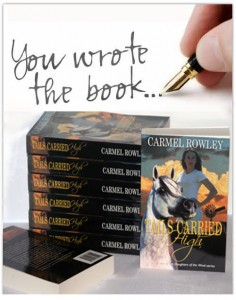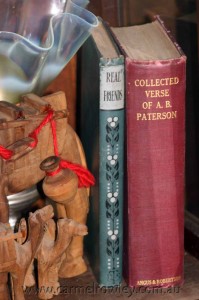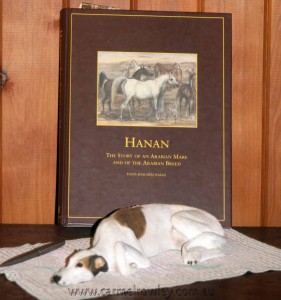More about book signing & your favourite signed books.
Being one of the ways an author connects with readers, I thought it might be nice to continue the discussion about book signing. Apart from mentioning some of my own treasured signatures and inscriptions I’ve included some information from people who know far more about the benefits of having a book signed than I do. Have you got a signed favourite? I would love to hear about it …
Without a doubt there are many of you who would have cherished books with equally important words inside written especially for you. One of my own most treasured, books is “Real Friends” awarded to my grandfather in 1917 for good conduct and attendance. When he passed the book onto me he wrote the most touching words to me. Another book I value, would be my copy of “Collected Verse of A.B. Patterson” a 1923 edition with his signature.
Probably the words written in my copy of “Hanan – The story of an Arabian Mare and of the Arabian breed” by Hans Joachim Nagel, is a most memorable inscription. Dr. Nagel wrote the words in his book for us when he visited Pearsons View while attending the WAHO Conference at the Gold Coast in 2000.
“Thanks for the late reception, but I wanted so much to see your nice collection of Arabians.
They were so familiar to mine having the same look. All the best to you Hans Nagel”
With regards to book signing Wikipedia http://en.wikipedia.org states: “Book signing is the affixing of a signature to the title page or flyleaf of a book by its author. A book signing is an event, usually at a book store or library where an author sits and signs books for a period. Book signing is popular because an author’s signature increases the value of books for collectors. The author may add a short message to the reader, called a dedication, to each book, which may be personalized with the recipient’s name upon request. A simple author’s signature without a dedication is typically more valuable to collectors (exceptions include inscriptions to persons of note, e.g. from Hemingway to Fitzgerald, or to persons of significance in the author’s life). Many authors today spend a great deal of time signing their books, and sign many thousands of copies. James Ellroy is known for signing every copy of the 65,000 strong first run of My Dark Places.
Book signings provide more than a just a chance to obtain signatures. Authors and bookstores are benefited by the fact that many copies of the book being promoted are sold. Signings also increase public goodwill and allow authors to connect with their fans. For fans, signings give them a chance to see and meet a favorite author and ask them questions.
Sometimes the author will sign additional copies for future sale. An additional advantage for authors for doing this is that once a book has been signed, it cannot be returned to the publisher for a refund.”
“Let us tenderly and kindly cherish therefore, the means of knowledge. Let us dare to read, think, speak, and write.” ~John Adams
Here are some interesting questions answered by RBMS – Rare Books and Manuscripts Section, USA. http://www.rbms.info
Is a book signed or marked up by a previous owner, or autographed by the author, more valuable?
The association of a book with a previous owner can add to its value, if that person is important or famous. Autographs, inscriptions or dedications, manuscript annotations, bookplates or stamps, or other distinctive markings may all be forged, so they need to be authenticated before a positive statement of association can be made. Contemporary authors routinely sign many copies of their books at publicity events organized to promote sales. Because they are common, such autographs typically add little to the market value of the book. Authors also sign books on other occasions, and they sometimes inscribe and present them to important associates and friends. Such “presentation” or “association” copies may command a premium price. Expert knowledge of the current market is needed in
What makes a book rare?
Millions of books, pamphlets, magazines, newspapers, and broadsides have been published since the invention of printing more than five hundred years ago. Only a small portion of these pieces, however, would be considered “rare” by specialists. In simple terms, books achieve a degree of rarity only when demand exceeds supply. Unfortunately, there are no easy formulas for determining rarity.
What makes a book important?
People value books either because of their contents or because of their physical characteristics. First editions of important literary or historical works and initial reports of scientific discoveries or inventions are prime examples of books that are important because of their contents. Illustrated books that give a new interpretation of a text or are the work of an esteemed artist are also valued. Books that were suppressed or censored may be both important and scarce, since few copies may have survived. Physical characteristics, such as a special binding; an early use of a new printing process; or an autograph, inscription, or marginal annotations of a famous person; may also contribute to a book’s importance and its market price.
“There is no such thing as a bad book, I just like some books more than others…” ~ Chris Geiger
Also an interesting excerpt from Ken Lopez – Bookseller Fine books and Manuscripts http://lopezbooks.com/articles/signed/
Signed vs. Inscribed by Ken Lopez
“One of the questions I’ve been asked most often in recent years is “Which is better — having a book just signed by the author or having it inscribed?” In general my answer has been that the more writing by the author in a book, the better. And most especially, I’ve encouraged collectors when getting their own books signed to have them personally inscribed by the author.
I know I’m bucking the current trend on this issue, but I continue to do so, and I think I’m right. Here’s why.
For a long time — generations, literally — there was a clearly established hierarchy of values that pertained to books signed by their authors. The best copy was the dedication copy, and usually there was only one of these. Next best were association copies, that is, books inscribed by the author to someone notable or important in the author’s life — a relative, a friend, a mentor, another writer. After that were “presentation copies,” which simply meant those books inscribed by the author to someone who was not important to the author, or whose importance was unknown. And finally, at the bottom of the hierarchy, were books that were just signed, with no further inscription, no other writing, etc.
In recent years, for reasons that most people don’t know about or are unable to articulate, the last two kinds of signed books have appeared to switch places in the hierarchy, with there being a preference in the marketplace for books that were just signed, rather than having been inscribed. I believe this preference, which flies in the face of longstanding tradition in the book collecting world, has a specific historical origin and that the seeming consensus in the marketplace reflects a backlash against specific practices by certain individuals which, in the fog of time, has come to look like a rational rethinking of the old priorities and a new philosophy toward signed books. The fact that we have mostly forgotten the historical reasons for this preference arising means that, for the most part, it is a preference based more on received wisdom than on careful, thoughtful consideration. And I believe that, as a result of its relatively thin basis in rational consideration, this preference is beginning to lose its hold in the marketplace and the old hierarchy will again, in time, reassert itself — and probably soon.”
Read the entire article at http://lopezbooks.com/articles/signed/



Leave a Reply